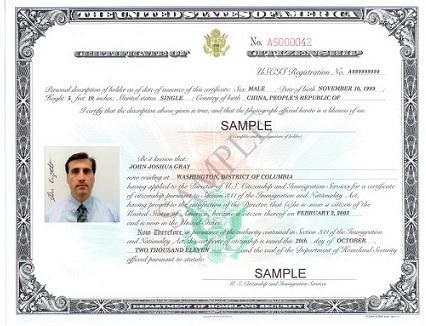A Certificate of Citizenship is an identity document proving U.S. citizenship. It is generally issued to derivative citizens and to persons who acquired U.S. citizenship. Derivation of citizenship is common for permanent resident children whose parent(s) naturalize. When certain requirements are met, the child automatically becomes a U.S. citizen. Acquisition of citizenship happens when a child is born outside the United States to at least one U.S. citizen parent. This certificate is different than a Certificate of Naturalization.

You have a citizenship certificate if the document contains the label “Form N-560” or “Form N-561” in the bottom margin.
Obtaining an Initial Citizenship Certificate
Initially, a person obtains a Certificate of Citizenship by filing Form N-600, Application for Certificate of Citizenship, with U.S. Citizenship and Immigration Services (USCIS). USCIS issues a certificate after an officer reviews the evidence and approves the application.
An individual who obtains U.S. citizenship through his or her parents may need to request a certificate to prove citizenship status. Derivation and acquisition are the two basic ways to obtain citizenship through one’s parents.
Derivation of Citizenship
Generally, a permanent resident child automatically becomes a U.S. citizen when one of his or her parents naturalize. As long as the child is residing in the United States in the custody of that U.S. citizen parent, he or she derives citizenship benefits from the relationship.
RECOMMENDED: Derivative Citizenship for Children of U.S. Citizens
Acquisition of Citizenship
A child born on U.S. soil is automatically a U.S. citizen. When U.S. citizen parents have a child abroad, this right to citizenship is generally extended to the child. A child born outside of the United States generally becomes a U.S. citizenship at birth if that child has at least one parent who is a U.S. citizen, and the U.S. citizen parent meets certain residence or physical presence requirements in the United States prior to the person’s birth.
RECOMMENDED: Acquisition of U.S. Citizenship
Replacement of Certificate of Citizenship
U.S. citizens who want to replace a Certificate of Citizenship may file Form N-565, Application for Replacement Naturalization/Citizenship Document, with USCIS. You can replace a certificate for the following reasons:
- Certificate was lost, stolen, destroyed or mutilated
- Certificate is incorrect due to a USCIS typographical/clerical error
- Name has legally changed
- Date of birth has legally changed
- Gender has legally changed
Mistakes on your N-565 application can cause costly delays or a denial.
Prepare your N-565 correctly and affordably with CitizenPath. The attorney-reviewed software guides you through the application and provides help to answer questions like this one. And personalized filing instructions help you to file your application today knowing that you did everything right! No credit card or signup required to get started. Try it before you buy it >>Contents of Certificate
The Certificate of Citizenship contains information identifying the person and confirming his or her U.S. citizenship. Specifically, the certificate contains:
- Certificate number (generally a red 6- to 8-digit alpha numeric number)
- Date person became a citizen
- Date of issuance
- USCIS registration number (A-number)
- U.S. citizen’s full name
- Marital status
- Place of residence
- Country of birth
- Photograph
- Signature of applicant; and
- Other descriptors: sex, date of birth, and height
The document also includes a Department of Homeland Security seal as well as a statement and signature by the USCIS Director indicating that the applicant complied with all the eligibility requirements for citizenship under the laws of the United States.
Obtaining a U.S. Passport
When applying for a U.S. passport, you may use the citizenship certificate as evidence of U.S. citizenship. You’ll need to provide a photocopy of your certificate as one of the passport requirements when submitting the application for a U.S. passport (DS-11).
